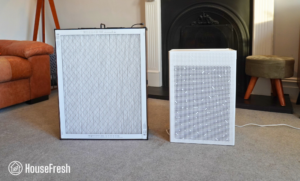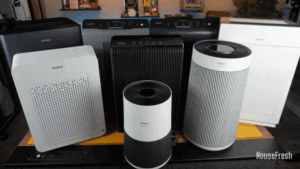Medical-grade air purifiers can remove more particles than standard H11 or H12 HEPA filters, which are often used in residential settings.
While H11 captures 95% of particles over 0.3 microns on a single pass, and H12 captures 99.5%, H13, often described as a medical-grade filter, offers enhanced particle removal rates, even from the smallest particles.
These filters can capture 99.97% of particles sized 0.3 microns or bigger, and H14 takes it a step further, removing 99.995% of particles for comprehensive protection from allergies, bacteria and viruses.
- According to the NHS in England: “For healthcare applications, it is recommended that devices should contain filters classified as High-Efficiency Particulate Air Filters (HEPA) under BS EN 1822-1 or ISO 29463-1.”
- The Department of Health in the state of Victoria in Australia claims: “Air cleaners equipped with H13 HEPA filters are recommended. Air cleaners with a lower grade filter may not be as efficient in removing airborne viral particles.”
- The CDC also recently updated its guidance on using HEPA filters for COVID-19: “Portable HEPA filtration units that combine a HEPA filter with a powered fan system are a preferred option for auxiliary air cleaning, especially in higher risk settings such as health clinics, vaccination and medical testing locations, workout rooms, or public waiting areas.”
- A 2021 academic study from Turkey’s Department of Public Health showed that air purifiers with an H13 filter certified by BS EN 1822-1 could reduce microbial load in the air and on surfaces and thus reduce the amount of hospital-acquired infections.
A medical-grade air purifier can be a great help to people suffering from asthma, COPD, immunocompromised or any medical issue requiring clean air that is free of viruses, bacteria or tiny harmful particles.
We also ensured each option had fair long-term costs and acceptable sound levels, even at the highest fan speed. For most situations, we recommend H13 filters over H14, as those filters are so dense that they can restrict airflow and lead to leakage risk as air tries to go around the filter.
The following air purifiers all utilize medical grade H13 filters and ranked highly in our particle removal test. We tested each of them following the same process:
The data we collect from our tests show us which air purifiers are high-performing and worthy of spending your hard-earned dollars on and which simply don’t make the grade.
Staff picks: Top 3 medical grade air purifiers
There are many air purifiers that utilize medical-grade filters on the market; here are my top three units that we’ve tested and reviewed.
| 👑 Best overall | 💰 The best performance per $ spent | 🛋️ The quietest option | |
|---|---|---|---|
| IQAir HealthPro Plus | AirDoctor AD3000 | Smart Air Blast Mini | |
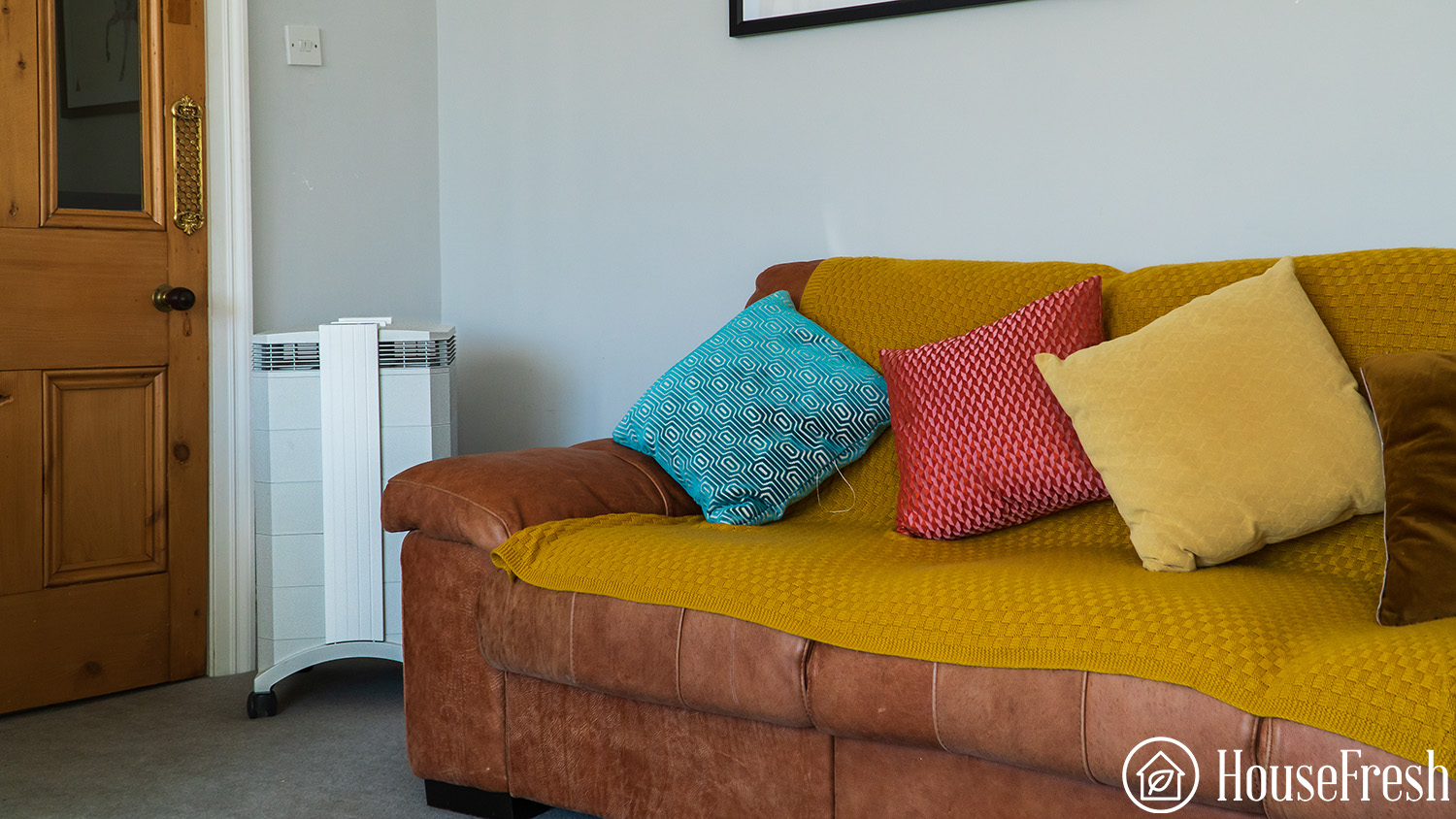 |  | 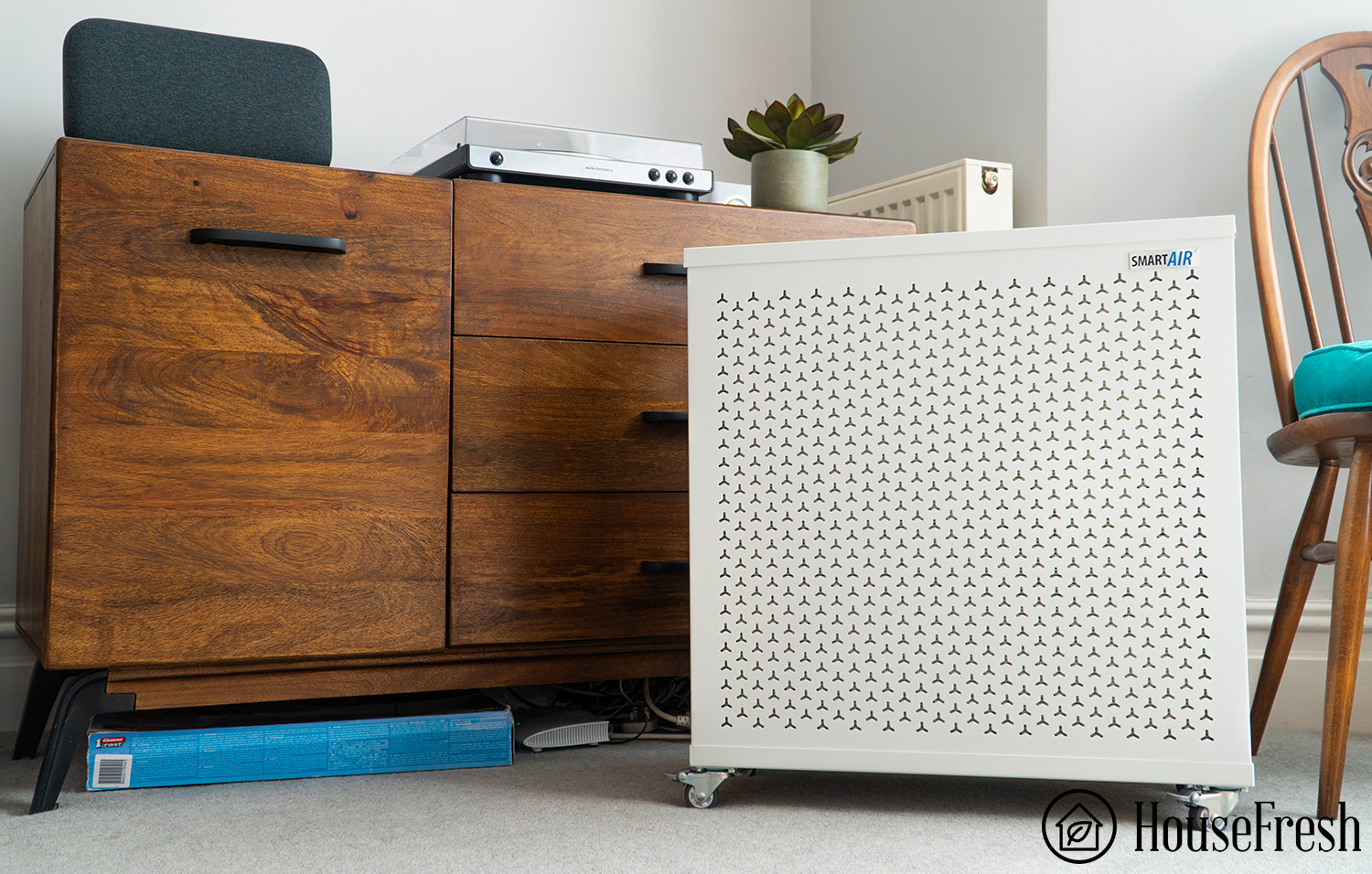 | |
| AIR CLEANING SPEED ⚡ | 25 minutes | 14 minutes (with ionizer function enabled) 16 minutes (without ionizer function | 12 minutes |
| CADR 👩🔬 | 250 CFM | 340 CFM | 450 CFM |
| FILTER TECHNOLOGY 💨 | HyperHEPA and V50-CELL gas and odor filter | UltraHEPA filter and dual-action Carbon/Gas Trap/VOC filter | H13 HEPA Filter |
| MAX ROOM SIZE 📏 | 1125 sq. ft. | 512 sq. ft. (4.8 ACH) | 703 sq. ft. |
| WEIGHT ⚖️ | 35 lbs (16 kg) | 18 lbs (8 kg) | 59 lbs (26.8 kg) |
| OUR REVIEW 🔍 | IQAir HealthPro Plus review | AirDoctor AD3000 review | Smart Air Blast Mini review |
| PRICE 💵 | $999.99 | $559.00 | Price not available |
Last update on 2025-07-02 / Affiliate links / Images from Amazon Product Advertising API
Let’s look a little deeper into my top recommendations, along with four more high-performing air purifiers and a couple of units that you should avoid at all costs.
1. Staff pick: IQAir Healthpro Plus
When it comes to medical grade HEPA filters, IQAir is top of the game — the Healthpro Plus offers the highest grade HEPA on the market today.
If you’re serious about air quality, suffer from severe allergies and/or respiratory disease(s) or live in a highly polluted area, the IQAir Healthpro Plus is a unit you should look into. This robust air purifier is engineered and built in Switzerland, and each unit is rigorously tested before being sent out into the world.
What we really like
What we think could be better
When you look under the hood of the Healthpro Plus, you’ll find its three carefully engineered filters that maximize its efficiency at removing airborne particles. IQAir’s HyperHEPA filter is the main attraction, which removes 99.5% of particles down to 0.003 microns. To put that into context, the size of SARS-CoV-2 ranges from 0.07 microns to 0.09 microns.
Although the IQAir Healthpro Plus may look intimidating, it’s simple to operate and has a clear screen to navigate through its settings. Plus, there’s a remote control if you need it. There are no smart functions like an auto mode or app connectivity; the Healthpro Plus strictly concentrates on air quality over gadgetry.
If you’re looking for an extremely high-performance medical-grade air purifier…you’ve just found one.
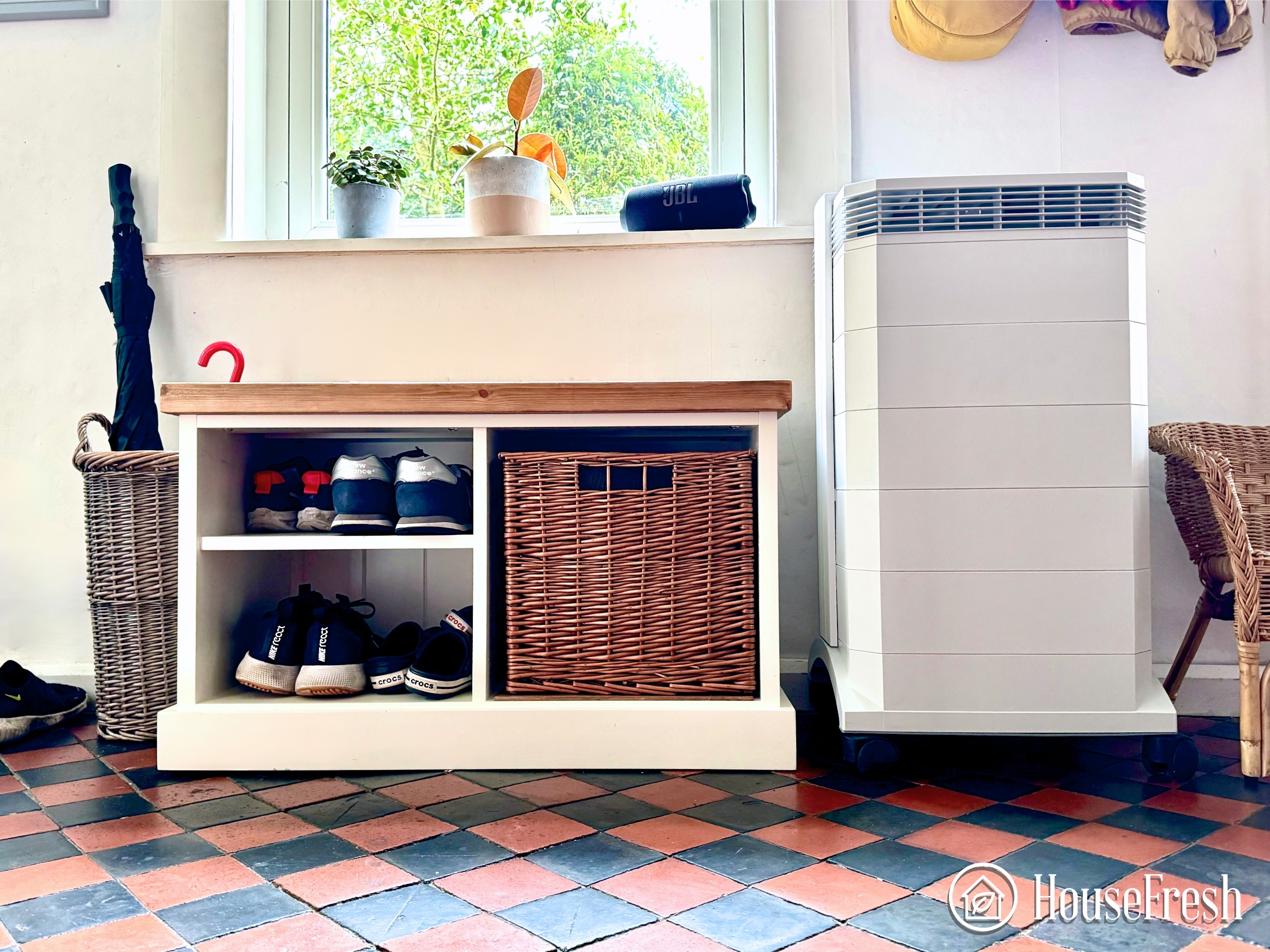
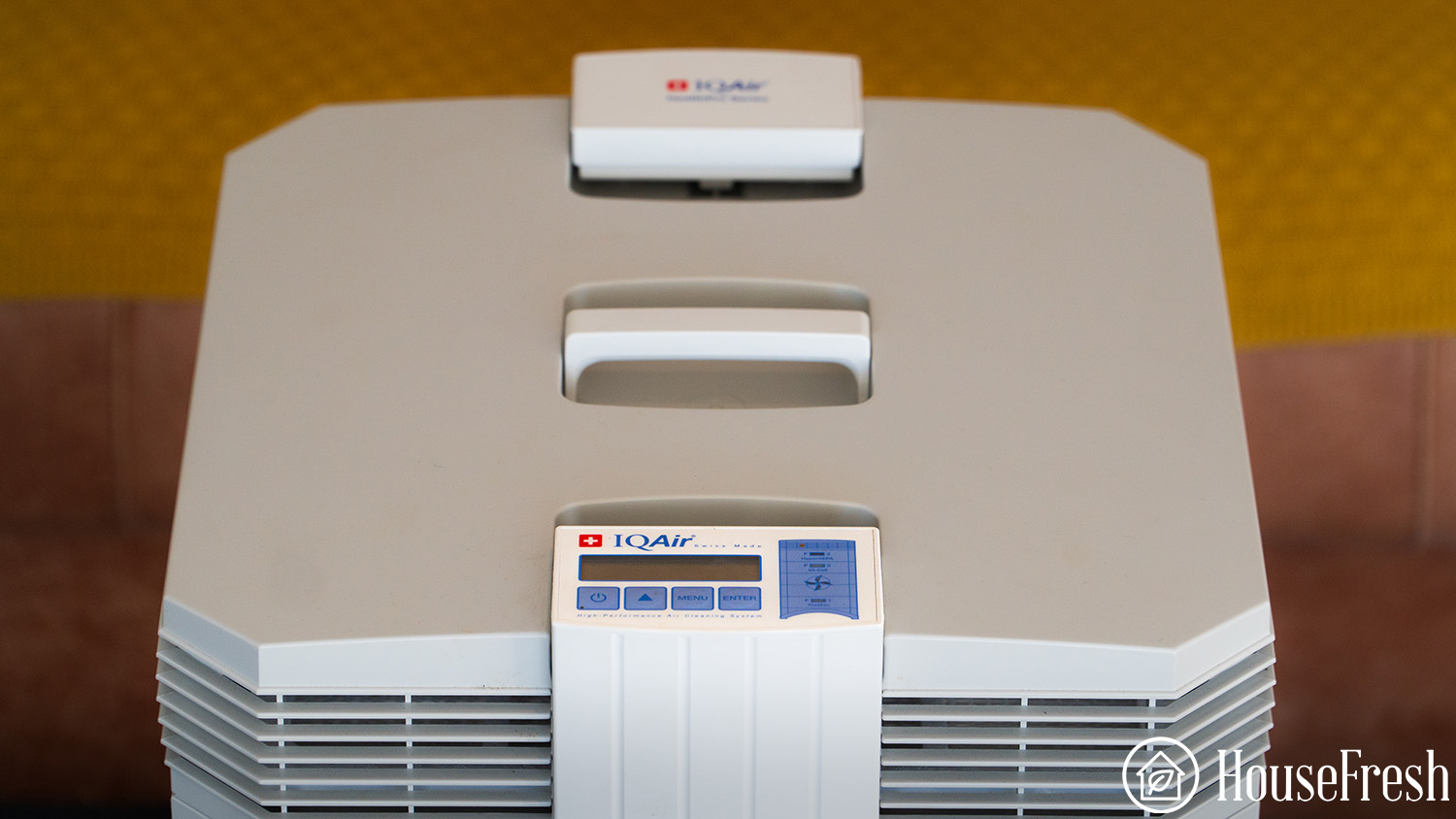
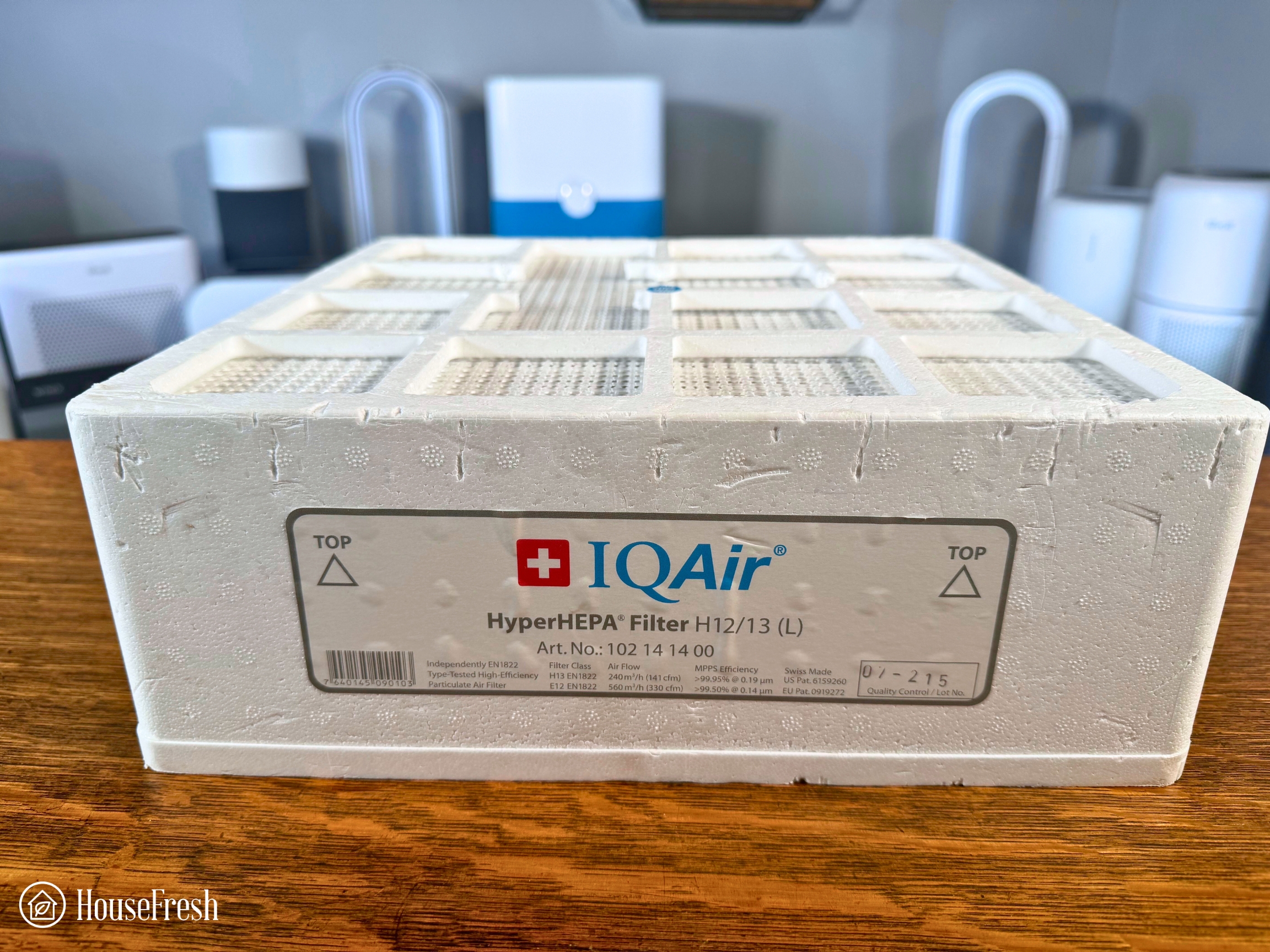
| HouseFresh rating: | ★★★★★ |
| Time to clean our 728 cubic feet test room (with the device running at top speed): | 28 minutes |
| Air purifier technology: | HyperHEPA and V50-CELL gas and odor filter |
| Recommended room size (5 air changes per hour): | 375 sq. ft. |
| Clean air delivery rate (CADR): | Estimated: 250 CFM |
| Dimensions (in inches / in cm): | 28H x 18W x 16D inches (71H x 38W x 41D cm) |
| Weight (in pounds / in kg): | 35 lbs (15.88 kg) |
| Filter life: | 4 years |
| Noise level (measured from 3 ft. away): | Speed 1: 36.9 dB Speed 2: 37.2 dB Speed 3: 40.9 dB Speed 4: 47.2 dB Speed 5: 53.9 dB Speed 6: 61.2 dB |
| Electricity consumption in watts (recorded with an electricity usage monitor): | Standby mode: 1 watts Speed 1: 16.5 watts Speed 2: 32.7 watts Speed 3: 47.3 watts Speed 4: 69 watts Speed 5: 94.3 watts Speed 6: 145.2 watts |
| Estimated running costs (electricity consumption + filter replacements): | $421.47 per year |
| Cost per CADR cfm (based on dust CFM as reported by AHAM): | $3.60 |
| Manufacturer’s warranty: | 10 years |
| Country of manufacture: | Switzerland / Germany |
2. The best performance per $ spent: AirDoctor AD3000
If you’re looking for a fast-acting medical-grade air purifier that won’t drain your bank balance – the doctor is in.

A lot of marketing hype surrounds the AD3000, making big claims about its performance. And, if I’m honest, the hype is justified. The performance of this air purifier leaves many of its rivals in the dust (pun intended) with its UltraHEPA (medical grade) filter, auto mode, AQI and a CADR of 340 CFM.
What we really like
What we think could be better
Danny (HouseFresh founder) has the AirDoctor 3000 running in his bedroom over all the air purifiers we have because of its high performance and awesome effectiveness of its UltraHEPA filter at removing airborne pollutants down to 0.003 microns (100 times smaller than a standard HEPA filter).
As well as a medical grade filter, the AD3000 comes with the usual features we expect from modern air purifiers, like an auto mode, timer and light dimmer. It also features an ionizer that can be switched on and off (if you don’t like it).
Even though the price is slightly on the higher side, you’re paying for medical grade UltraHEPA filters and it’s one of the best performance per $ spent on the market today.



| HouseFresh rating: | ★★★★☆ |
| Time to clean our 728 cubic feet test room (with the device running at top speed): | 14 minutes (with ionizer function enabled) 16 minutes (without ionizer function) |
| Air purifier technology: | UltraHEPA filter and dual-action Carbon/Gas Trap/VOC filter |
| Recommended room size (4.8 air changes per hour): | 521 sq. ft. |
| Clean air delivery rate (CADR): | Dust: 339 CFM Smoke: 336 CFM Pollen: 356 CFM |
| Dimensions (in inches / in cm): | 19.87D x 27.16W x 12.38H inches (50.4D x 69W x 31.4H cm) |
| Weight (in pounds / in kg): | 18 lbs (8 kg) |
| Filter life: | UltraHEPA filter: 12 months Carbon/Gas Trap/VOC filter: 6 months |
| Noise level in decibels (measured from 3 ft. away with a sound level meter): | Speed 1: 40.2 dB Speed 2: 50.5 Speed 3: 58.2 dB Speed 4: 63.6 dB |
| Electricity consumption in watts (recorded with an electricity usage monitor): | Standby mode: 0.5 watts Speed 1: 9.6 watts Speed 2: 17.6 watts Speed 3: 39.9 watts Speed 4: 93.2 watts |
| Estimated running cost (electricity consumption + official filter replacement): | $267.16 per year |
| Cost per CADR cfm (based on dust CFM as reported by AHAM): | $1.53 |
| Manufacturer’s warranty: | 1 year |
| Country of manufacture: | China |
3. The quietest option: Smart Air Blast Mini
A medical grade air purifier built like a tank – This powerful unit delivers a CADR of 450 CFM with ninja-like sound.

Smart Air doesn’t make air purifiers like other brands. You won’t find smart features, an AQI or control screens; they believe in the core science.
The Blast Mini is a testament to these beliefs. There’s just one dial to control the fan speed…that’s it. But that’s not a bad thing, as they put all their efforts into engineering the Blast Mini into a high-powered air-cleaning beast.
What we really like
What we think could be better
Even though this large air purifier uses a high-performance fan, Smart Air has managed to keep its sound output to a minimum. The average maximum noise produced across all air purifiers we’ve tested is 64 dB; the Blast Mini kicks out just 56 dB at its highest fan speed and 45 dB at its lowest.
The medical-grade HEPA filter in the Blast Mini is enormous. Smart Air has wasted no room in this unit, as the filter takes up the whole front. This huge filter has a lot of surface area to capture pollutants so that it can last 12 months over the usual 6 months. This, combined with a large fan, makes the Blast Mini an excellent option for a medical-grade air purifier.

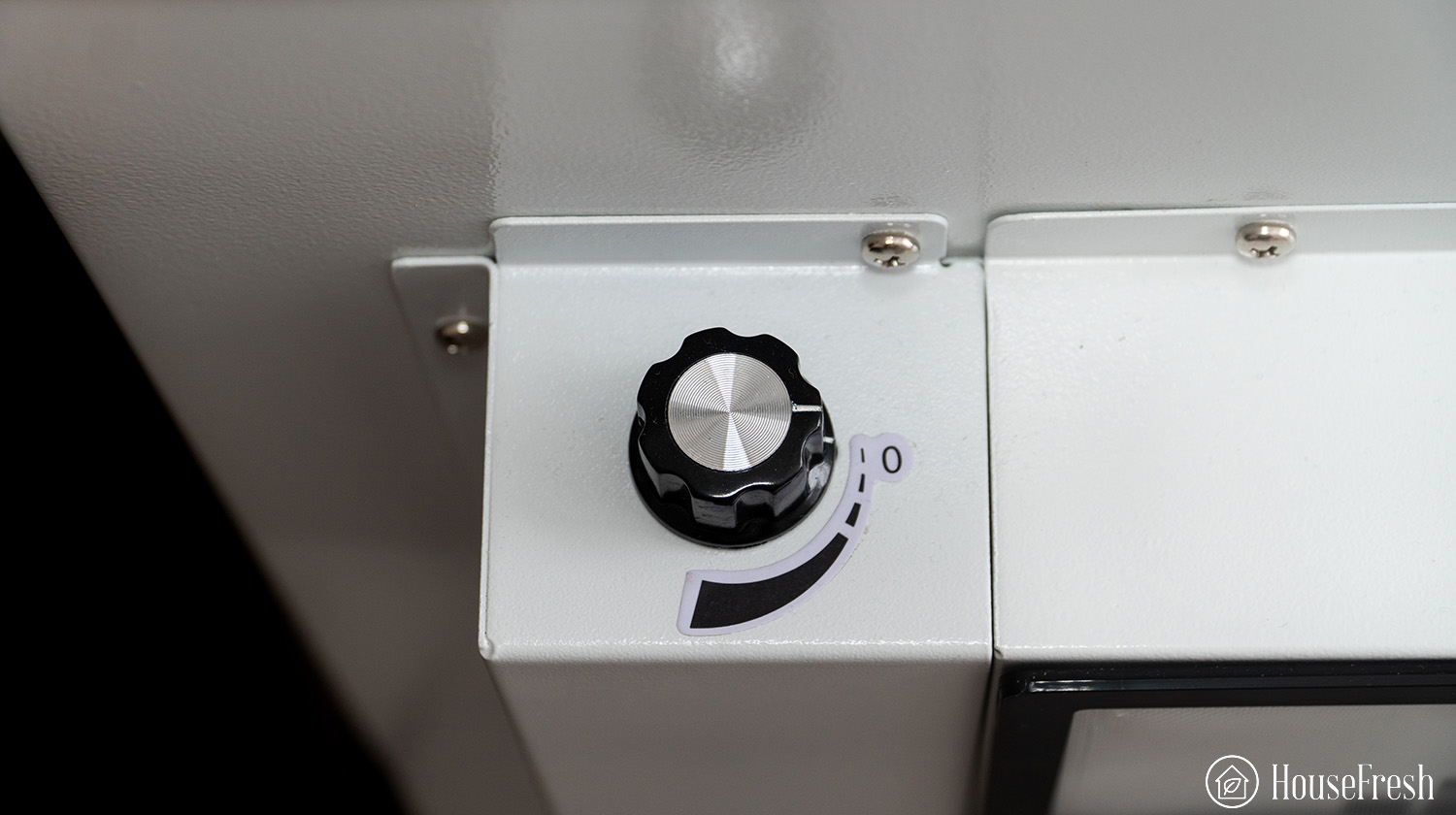

For many consumers, the main benefit of the Smart Air over the IQAir Healthpro Plus will boil down to price; it costs $600 vs $899 for the IQAir HealthPro Plus. All while providing faster results in our clean air test.
| HouseFresh rating: | ★★★★★ |
| Time to clean our 728 cubic feet test room (with the device running at top speed): | 15 minutes |
| Air purifier technology: | H13 HEPA filter (and optional activated carbon filter) |
| Recommended room size (4.8 air changes per hour): | 703 sq. ft. |
| Clean air delivery rate (estimated CADR): | 435 CFM |
| Dimensions (in inches / in cm): | 22.6L x 13W x 24.8H inches (57.5L × 33W × 63H cm) |
| Weight (in pounds / in kg): | 59 lbs (26.8 kg) |
| Filter life: | 13 months |
| Noise level in decibels (measured from 3 ft. away with a sound level meter): | Speed 1: 44.9 dB Speed 2: 51.2 dB Speed 3: 56.3 dB |
| Electricity consumption in watts (recorded with an electricity usage monitor): | Standby mode: 0 watts Speed 1: 51.9 watts Speed 2: 87.4 watts Speed 3: 122.7 watts |
| Estimated running cost (electricity consumption + official filter replacement): | $285.29 per year |
| Cost per CADR cfm (based on dust CFM as reported by AHAM): | $1.38 |
| Manufacturer’s warranty: | 1 year |
| Country of manufacture: | China |
4. Best wall-mounted option: Smart Air SA600
Smart Air proves that medical-grade air purifiers don’t need bells and whistles to be effective.

Smart Air has solidified itself as a trustworthy brand in the world of air purifiers. Their no-nonsense approach to engineering over gadget ingenuity has proven highly effective. With a dual-inlet comprising two medical-grade HEPA filters and two activated carbon filters, the SA600 is no different.
What we really like
What we think could be better
Compared to the Blast Mini, the SA600 couldn’t be more different on the outside, but it’s the inside that counts, right? This smaller unit still packs a punch and earned its spot in this guide with its dual H13 grade HEPA filters at the forefront of its cleaning performance.
These two medical-grade filters are engineered and tested to remove 99.97% of airborne particles in your home, like dust, pet dander, allergens and even viruses smaller than COVID-19. Combine that with Smart Air’s powerful fans and you have a strong deterrent against pollution.



| Clean air delivery rate (CADR): | – Top speed PM1 CADR: 249 cfm – Sub-45 dBA PM1 CADR: 128 cfm – AHAM PM2.5 CADR: 287 cfm (dust) |
| Filter technology: | H13 TrueHEPA filter with a removable pre-filter and pelleted activated charcoal filter (set of two) |
| Recommended room size: | 373 sq. ft. (5 air changes per hour) |
| Dimensions: | 20 x 13.8 x 9 inches (51 x 35 x 23 cm) |
| Weight: | 15.5 lbs (7 kg) |
| Noise level in decibels from 3 ft. away: | Speed 1: 35.2 dBA Speed 2: 37.2 dBA Speed 3: 41.5 dBA Speed 4: 46.1 dBA Speed 5: 56.7 dBA |
| Electricity consumption in watts: | Standby: 0.1 watts Speed 1: 2.4 watts Speed 2: 4.3 watts Speed 3: 7.1 watts Speed 4: 12.9 watts Speed 5: 53.8 watts |
| Filter lifespan: | HEPA: 8 months Carbon: 4 months |
| Manufacturer’s warranty: | 1 year |
| Country of origin: | China |
| Country of manufacture: | China |
5. Mila
A futuristic air purifier with a brain that doesn’t solely rely on smart technology to clean the air in your home.

When it comes to computer technology, the Mila is the opposite of Smart Air. This medical-grade air purifier is packed with features and settings so you can tailor your unit to your needs and wants. Combine that with seven different filters to choose from (yes, I said seven), and you’ve got an air purifier that’s totally customizable to your home.
What we really like
What we think could be better
You can’t deny it; the Mila is a good looking air purifier with its wooden legs and curved body. The highlight of this unit is the machine brain. We haven’t quite reached AI status in air purifiers yet, but this is the closest you will get. I spent a while looking through each setting and I don’t think I would use them all, but they’re there if I want them.
Pretty face, big brain and filters to match. The options range from the basic H12 HEPA right up to an H14 HEPA packed with 1.25 lbs of activated carbon to remove odors and VOCs from your air, making the Mila even more customizable. If you’re looking for a medical-grade air purifier with plenty of features, you can’t go wrong with the Mila.

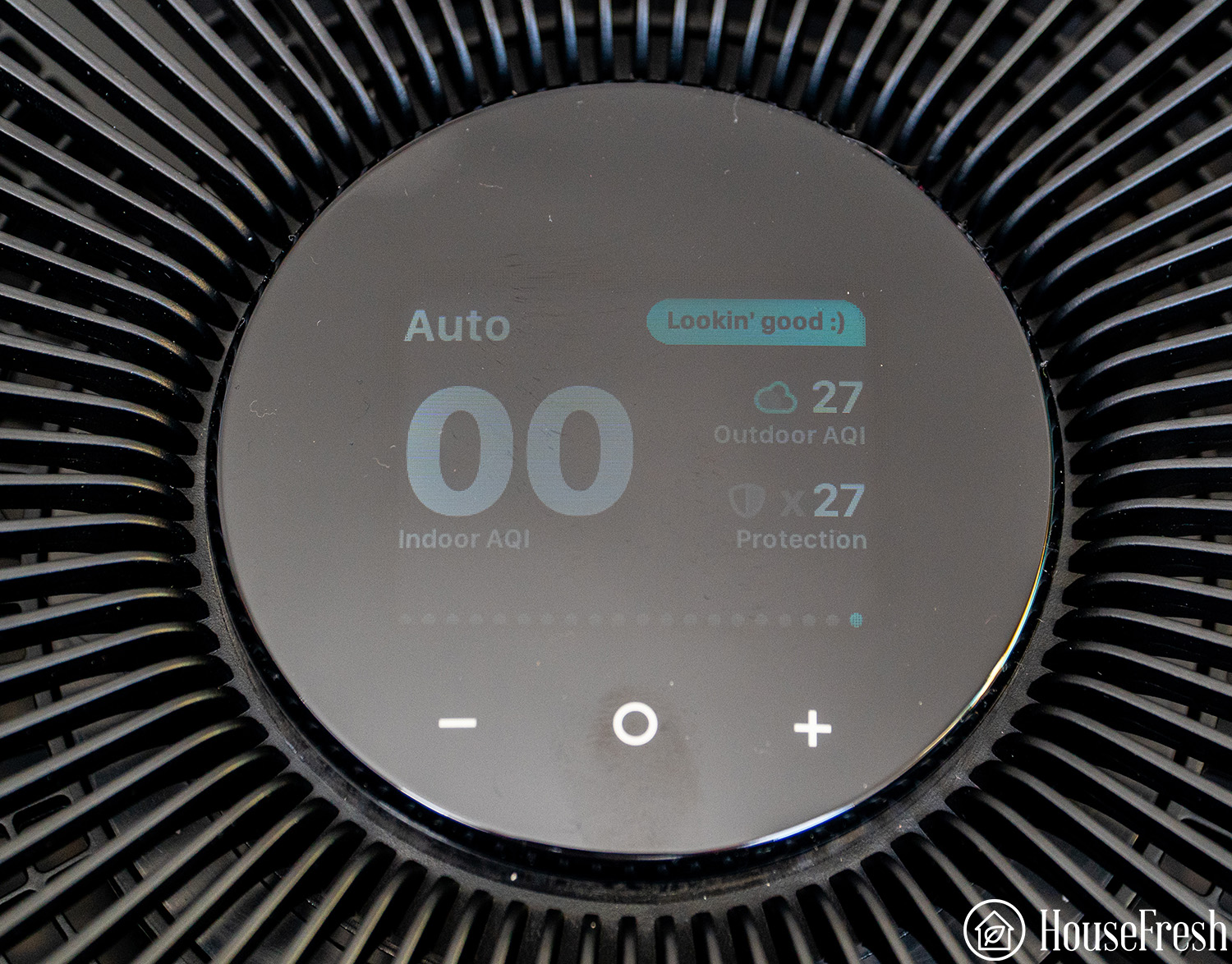
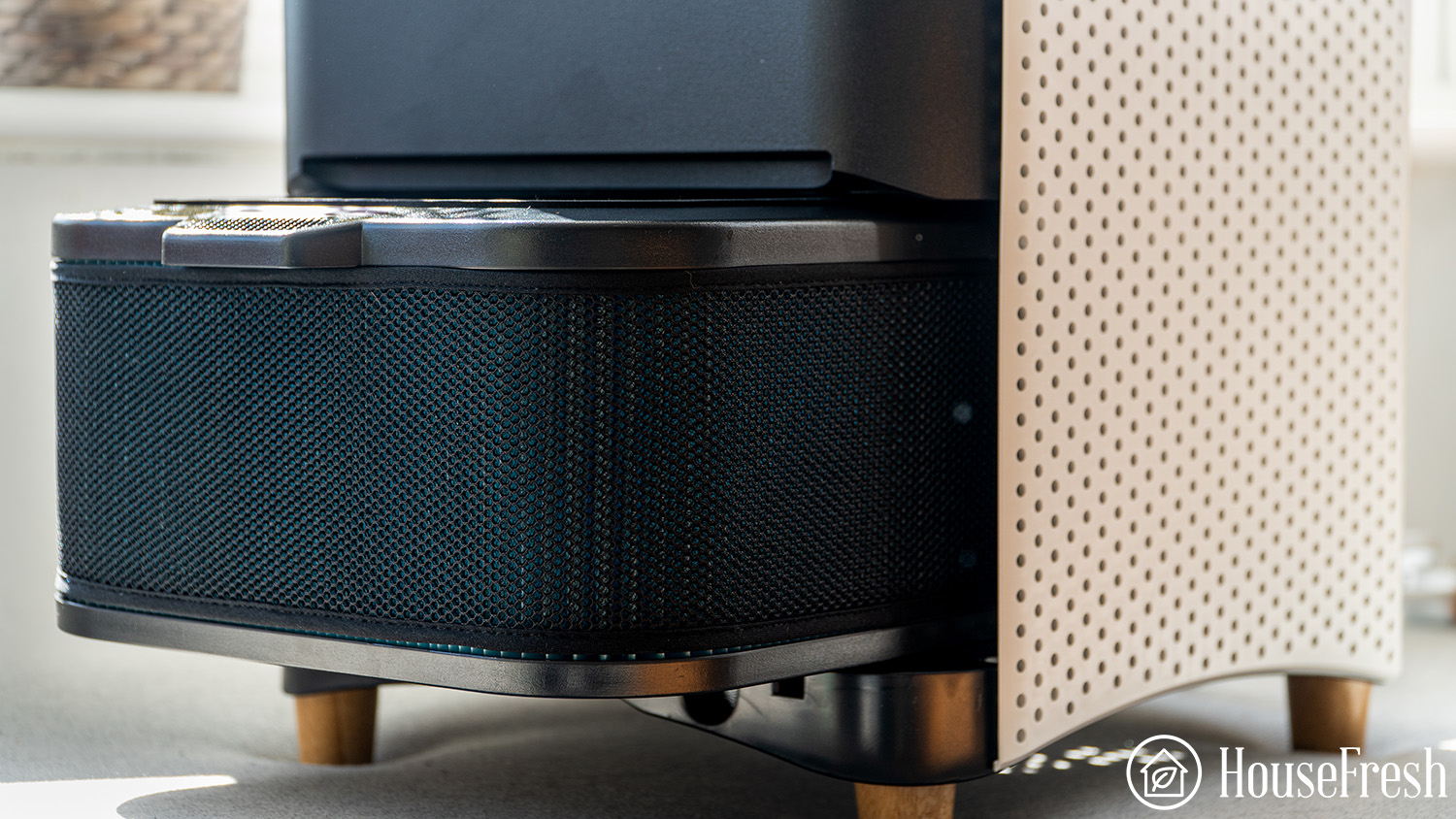
| HouseFresh rating: | ★★★★☆ |
| Time to clean our 728 cubic feet test room (with the device running at top speed): | 35 minutes |
| Air purifier technology: | HEPA (ranges from H12-H14) and ganular activated carbon filter |
| Recommended room size (4.8 air changes per hour): | 217 sq. ft. |
| Clean air delivery rate (CADR): | Dust: 146 CFM Smoke: 140 CFM Pollen: 152 CFM |
| Dimensions (in inches / in cm): | 12L x 12W x 15H inches (30.48L x 30.48W x 38.1H cm) |
| Weight (in pounds / in kg): | 18 lbs (8.16 kg) |
| Filter life: | 6 months |
| Noise level in decibels (measured from 3 ft. away with a sound level meter): | Speed 1: 37.5 dB Speed 3: 42.2 dB Speed 6: 54.8 dB Speed 8: 58.8 dB Speed 10: 59.2 dB |
| Electricity consumption in watts (recorded with an electricity usage monitor): | Standby mode: 5.62 watts Speed 1: 8.42 watts Speed 3: 10.1 watts Speed 6: 20.45 watts Speed 8: 36.2 watts Speed 10: 38.32 watts |
| Estimated running cost (electricity consumption + official filter replacement): | $208.45 per year |
| Cost per CADR cfm (based on dust CFM as reported by AHAM): | $3.22 |
| Manufacturer’s warranty: | 1 year |
| Country of manufacture: | Designed in the U.S., assembled in China |
6. Dyson Purifier Cool TP07
The TP07 showcases a combination of air purifier and fan that utilizes H13 HEPA filters.

Dyson is at the forefront of home devices, pioneering new technology and design in vacuum cleaners, hair care and now, air purifiers. The TP07 has two different features that can be used simultaneously. It’s a rotating fan and an air purifier containing medical-grade filters. It may not have the fastest cleaning performance in this guide, but its features and style make up for that.
What we really like
What we think could be better
Dyson isn’t known for shying away from innovative design, and the TP07 is no different. This towering unit takes up little floor space and can rotate 360 degrees to distribute clean air evenly. There is only one physical button to switch the unit on/off, so you use the remote control or the Dyson app to change the settings. Here, you can adjust the fan speeds, switch to auto mode, adjust the fan direction and engage rotation.
The display screen is very informative, showing you the quality of the air, fan speed, rotation and fan settings, timer and humidity, all with high-quality graphics. Under the hood, you find the medical grade HEPA filter in two halves. These easily click onto the body, saving you time when replacing them.
If you have the budget, the TP07 is a stylish combi unit with H13 HEPA filters.



| Clean air delivery rate (CADR): | – Top speed PM1 CADR: 94 cfm – Sub-45 dBA PM1 CADR: 58 cfm – AHAM PM2.5 CADR: 89.8 cfm (dust) |
| Filter technology: | HEPA H13 and activated carbon filter |
| Recommended room size: | 141 sq. ft. (5 air changes per hour) |
| Dimensions: | 7.7 x 8 x 41 inches (19.56 x 20.32 x 104.14 cm) |
| Weight: | 11 lbs (4.99 kg) |
| Noise level from 3 ft. away: | Speed 1: 38.9 dB Speed 2: 44.9 dB Speed 3: 50.2 dB Speed 4: 56 dB |
| Electricity consumption in watts: | Standby mode: 0.9 watts Speed 1: 3.5 watts Speed 2: 4.9 watts Speed 3: 10 watts Speed 4: 22.3 watts Speed 5: 28.9 watts |
| Filter life: | 12 months |
| Manufacturer’s warranty: | 2-year parts and labor warranty |
| Country of origin: | UK |
| Country of manufacture: | Malaysia |
Other medical-grade air purifiers that we tested but don’t recommend
As with most products, you have the good and the bad. There are air purifiers that use medical-grade HEPA filters but don’t have the performance or power to get the most out of them. Here are two units we own that we suggest you avoid at all costs.
- Levoit EverestAir – If you’ve seen our review of the EverestAir from Levoit, you’ll know how highly we rate this air purifier. Unfortunately, due to recent challenges made by Dyson concerning false advertising, Levoit has removed all mention of ‘HEPA’ from their branding. This means we can’t possibly include it in this guide.
What to look for when buying a medical-grade air purifier
Medical-grade air purifiers use a HEPA grade filter known as H13, which can trap 99.97% of particles sized 0.3 microns or bigger. While this type of medical-grade filter will be able to capture tiny particles such as viruses, you will still need to ensure that you can provide enough airflow to clean the air in your room.
But, with so many medical-grade air purifiers on the market, it can be tough to decide which is right for your home. Luckily, there are guidelines to follow to make sure you get the most out of your new air purifier.
Here are the top things to consider when choosing a medical-grade air purifier that are often overshadowed, yet more important than the initial cost and design of the unit.
1. Has the HEPA H13 received confirmation by independent evaluation?
The use of the term HEPA H13 is not regulated, so it’s easy for air purifier manufacturers to use this terminology even when they haven’t tested their filters through an independent body.
With Levoit recently removing the HEPA term from their marketing, it’s not just smaller brands you need to worry about.
To avoid risking buying a device that isn’t HEPA H13, you need to stick to companies that prove that they have had their HEPA filters tested by an independent body. The EU rules are BS EN 1822-1:2019; for the rest of the world, you will want to look for ISO29463.
For those with serious medical issues, you are better off spending more money on a brand like IQAir or Smart Air that are very open about their independent testing and avoiding cheaper brands that seem to offer the same features at a far cheaper price.
2. How big is your room?
It’s not just the grade of the filter that counts; it’s also the air purifier’s performance. The size of your room heavily dictates which air purifier will work effectively in it. Using the measurement CADR (Clean Air Delivery Rate), we can calculate how effective an air purifier will be at cleaning the air in different-sized rooms.
The general rule is the larger the room, the higher the CADR is needed.
As well as CADR, you also need to consider ACH (Air Changes per Hour). While first-pass filtration is helpful, it’s even more critical that an air purifier can clean enough air to provide at least 4.8 air changes per hour.
For example, for a 350 sq ft room, you would need an air purifier with at least a CADR of 224 to provide 4.8 ACH (what the EPA recommends for portable air purifiers.) This is much lower than the 98 CFM that the Dyson combo units provide, meaning a room that size would still suffer from particulate pollutants.
It is essential that you accurately measure your room first, then work out what CADR you will need to clean it effectively. Feel free to enter your room size in our CFM calculator tool to see the CADR needed to keep the air clean in your room:
3. What are the long-term costs of running an air purifier?
For those wanting to keep the air clean all the time, you will need to ensure your air purifier runs 24/7, 365 days a year. If your air purifier is inefficient, it can end up adding a higher cost to your electricity bill.
It’s not just the cost of energy you need to consider, as all HEPA filters need replacing once they become full of particles. Eventually, airflow gets restricted so that they cannot clean as efficiently so you need to buy a new filter periodically to keep your air purifier performing to its highest standard.
Some air purifier brands prey on consumers not thinking about the long-term costs when buying, so they offer cheaper units that cost much more in the long term in filter replacement costs.
There are now a lot of generic filters available for different models of air purifiers that cost much less, but if you are concerned about HEPA H13, be sure to stick to the genuine filters that will have been independently tested.
Common questions about issue
HEPA filters are graded by their efficiency. True HEPA is HEPA grade H11 and H12. H13 HEPA is a grade higher and blocks 99.97% of particles sized 0.3 microns or bigger.
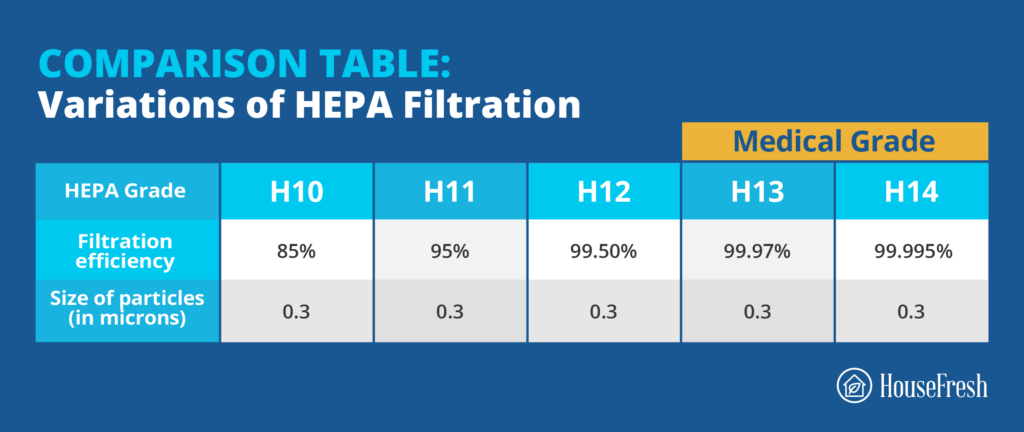
Most hospital buildings will use large air distribution systems incorporating MERV 8 pre-filters and MERV 14 final filters. High-risk areas like operating theatres will utilize medical-grade HEPA filters to achieve at least 15 air changes per hour to reduce the risk of infection. Other rooms will have different air change targets depending on the level of risk; you can see a full list of air change requirements at the CDC.
The filters that we find in air purifiers are rigorously tested beforehand. Each is rated on its ability to capture particles of different sizes. This is known as a Minimum Efficiency Reporting Values (MERV) rating, which ranges from a low H1 to a high H20.
According to NHS England, ionizers should be avoided as they have the potential to create chemical byproducts via secondary reactions. Currently, there needs to be more evidence of their efficacy in reducing microbial loads in the air.
According to the team at Commercial Air Filtration, HEPA H13 is better as it doesn’t restrict airflow as much, has a better filtration-to-airflow ratio and is less likely to suffer from air leakages.
For those with a medical issue, investing in an air purifier that uses filters with HEPA H13 is worth investing in. However, you still need to make sure that the air purifier has enough cleaning power to provide regular air changes for the space you are in. Any type of air purifier will still be able to keep the air clean eventually, even if the grade of HEPA is lower as the airflow will be increased so the devices can move air quicker so even the MERV 13 of the Corsi-Rosenthal box can still remove the tiniest of particles from the air even though the filter it uses is lower than HEPA grade.
As air purifiers have become more of a requirement than a luxury item, doctors will most likely point out how running a unit in your home is a much healthier option than not. But it all comes down to your insurance plan. Many companies like Medicaid only cover DME (Durable Medical Equipment) which air purifiers (at time of writing) don’t currently fall under.
Wrapping up
Running an air purifier in your home is the best way to remove harmful airborne pollutants from your air. The scientific data to back this up is ample and well-documented. Air purifiers that contain a medical-grade filter will stop more particles in a single pass than low grade filters.
The trick is to find an air purifier that is right for your space and has enough power to utilize its high-grade filters efficiently and effectively. Each unit I have featured in this article is high-performing; some have more brains than brawn, and vice versa.
Which will you choose for your home?
Unlike most other air purifier guides online, we are independent of a large media company. Our number one focus is helping more people improve their indoor air quality. While most other guides play lip service to “performance testing,” we publish all our data, which you can find in the over 60 air purifier reviews we have completed since 2020.
We don’t have any relationships with air purifier manufacturers or brands, so we don’t need to worry about keeping anyone happy other than our readers. We want more people to be able to improve indoor air quality by finding an air purifier that works for them, which means we focus on uncovering bad buys you need to avoid.
If you want to speak to me directly, don’t hesitate to email me directly, as I love to hear from readers: teddy@housefresh.com



